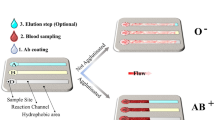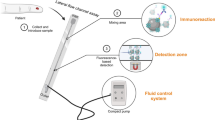Abstract
A recently developed blood typing diagnostic based on a polyester thread substrate has shown great promise for use in medical emergencies and in impoverished regions. The device is easy to use and transport, while also being inexpensive, accurate, and rapid. This study used a fluorescent confocal microscope to delve deeper into how red blood cells were behaving within the polyester thread-based diagnostic at the cellular level, and how plasma separation could be made to visibly occur on the thread, making it possible to identify blood type in a single step. Red blood cells were stained and the plasma phase dyed with fluorescent compounds to enable them to be visualised under the confocal microscope at high magnification. The mechanisms uncovered were in surprising contrast with those found for a similar, paper-based method. Red blood cell aggregates did not flow over each other within the thread substrate as expected, but suffered from a restriction to their flow which resulted in the chromatographic separation of the RBCs from the liquid phase of the blood. It is hoped that these results will lead to the optimisation of the method to enable more accurate and sensitive detection, increasing the range of blood systems that can be detected.

Agglutinated FITC stained A+ blood on anti-A antibody treated thread. Sheet like structures composed of agglutinated RBCs can be seen, wrapped around fibres and occupying the spaces between them





Similar content being viewed by others
References
World Health Organization (2014) http://www.who.int/mediacentre/factsheets/fs279/en/ visited on November 2014
Watkins WM (2001) The ABO blood group system: historical background. Transfus Med 11:243–265
Daniels G, Bromilow I (2007) Essential guide to blood groups. Blackwell Publishing Ltd, Oxford
Joshi V (2006) Anatomy and physiology for nursing and health care. BI Publications, New Delhi
Malomgré W, Neumeister B (2009) Recent and future trends in blood group typing. Anal Bioanal Chem 393:1443–1451
Dean L (2005) Blood groups and red cell antigens. National Center for Biotechnology Information (NCBI), Bethesda
Estridge BH, Reynolds AP, Walters NJ (2000) Basic medical laboratory techniques. Delmar Cengage Learning, Albany
Pramanik D (2010) Principles of physiology. Academic Publishers, Kolkata
Llopis F, Carbonell-Uberos F, Montero MC, Bonanad S, Planelles MD, Plasencia I, Riol C, Planells T, Carrillo C, De Miguel A (1999) A new method for phenotyping red blood cells using microplates. Vox Sang 77:143–148
Llopis F, Carbonell-Uberos F, Planelles MD, Montero M, Puig N, Atienza T, Alba E, Montoro JA (1997) A monolayer coagglutination microplate technique for typing red blood cells. Vox Sang 72:26–30
Langston MM, Procter JL, Cipolone KM, Stroncek DF (1999) Evaluation of the gel system for ABO grouping and D typing. Transfusion 39:300–305
LaPierre Y, Rigal D, Adam J, Josef D, Meyer F, Greber S, Drot C (1990) The gel test: a new way to detect red cell antigen-antibody reactions. Transfusion 30:109–113
Plapp FV, Rachel JM, Sinor LT (1986) Dipsticks for determining ABO blood groups. Lancet 327:1465–1466
Giebel F, Picker SM, Gathof BS (2008) Evaluation of four bedside test systems for card performance, handling and safety. Transfus Med Hemother 35:33–36
Yager P, Edwards T, Fu E, Helton K, Nelson K, Tam MR, Weigl BH (2006) Microfluidic diagnostic technologies for global public health. Nature 442:412–41816
Nilghaz A, Ballerini DR, Fang XY, Shen W (2014) Semiquantitative analysis on microfluidic thread-based analytical devices by ruler. Sensors Actuators B Chem 191:586–594
Nilghaz A, Ballerini DR, Shen W (2013) Exploration of microfluidic devices based on multi-filament threads and textiles: a review. Biomicrofluidics 7:051501–051516
Ballerini DR, Li X, Shen W (2011) Flow control concepts for thread-based microfluidic devices. Biomicrofluidics 5:14105
Li X, Tian J, Shen W (2009) Thread as a versatile material for low-cost microfluidic diagnostics. ACS Appl Mater Interfaces 2:1–6
Safavieh R, Mirzaei M, Qasaimeh MA, Juncker D (2009) Yarn based microfluidics: from basic elements to complex circuits, in MicroTAS, The thirteenth International Conference on Miniaturized Systems for Chemistry and Life Sciences 2009. The Chemical and Biological Microsystems Society, Jeju
Safavieh R, Zhou GZ, Juncker D (2011) Microfluidics made of yarns and knots: from fundamental properties to simple networks and operations. Lab Chip 11:2618–2624
Reches M, Mirica KA, Dasgupta R, Dickey MD, Butte MJ, Whitesides GM (2010) Thread as a matrix for biomedical assays. ACS Appl Mater Interfaces 2:1722–1728
Ballerini DR, Li X, Shen W (2011) An inexpensive thread-based system for simple and rapid blood grouping. Anal Bioanal Chem 399:1869–1875
Khan MS, Thouas G, Shen W, Whyte G, Garnier G (2010) Paper diagnostic for instantaneous blood typing. Anal Chem 82:4158–4164
Li M, Tian J, Al-Tamimi M, Shen W (2012) Paper-based blood-typing device that reports patient's blood type "in writing". Angew Chem Int Ed Engl 51:5497–5501
Al-Tamimi M, Shen W, Zeineddine R, Tran H, Garnier G (2011) Validation of paper-based assay for rapid blood typing. Anal Chem 84:1661–1668
Li L, Tian J, Ballerini D, Li M, Shen W (2013) A study of the transport and immobilisation mechanisms of human red blood cells in a paper-based blood typing device using confocal microscopy. Analyst 138:4933–4940
Fourné F (1999) Synthetic fibers: machines and equipment, manufacture, properties: handbook for plant engineering, machine design, and operation. Hanser/Gardner Publications, Cincinnati
Sauer M, Hofkens J, Enderlein J (2010) Handbook of fluorescence spectroscopy and imaging: from ensemble to single molecules. Wiley, USA
Tellier F, Steibel J, Chabrier R, Blé FX, Tubaldo H, Rasata R, Chambron J, Duportail G, Simon H, Rodier JF, Poulet P (2012) Sentinel lymph nodes fluorescence detection and imaging using Patent Blue V bound to human serum albumin. Biomed Opt Express 3:2306–2316
Fernandes HP, Cesar CL, Barjas-Castro MDL (2011) Electrical properties of the red blood cell membrane and immunohematological investigation. Rev Bras Hematol Hemoter 33:297–301
Roberts RJ, Senden TJ, Knackstedt MA, Lyne MB (2003) Spreading of aqueous liquids in unsized papers is by film flow. J Pulp Pap Sci 29:123–131
Khan M, Kannangara D, Garnier G, Shen W (2011) Effect of liquid droplet impact velocity on liquid wicking kinetics in surface V-groovdes. Chem Eng Sci 66:6120–6127
Tian J, Kannangara DS, Li X, Shen W (2010) Capillary driven low-cost V-groove microfluidic device with high sample transport efficiency. Lab Chip 10:2258–2264
Acknowledgments
The authors would like to thank The Melbourne Centre for Nanofabrication (MCN) for providing world-class facilities, including the confocal microscope used in the study. We also thank Dr John Zhu of the MCN for his guidance and instruction in the use of the confocal microscope. The authors also thank Dr Lijing Wang of the School of Fashion and Textiles, RMIT University, for kindly providing the thread samples and Dr Ying Hui Ngo for her assistance in capturing SEM images of the thread used, and the Monash Centre for Electron Microscopy for providing SEM facilities. The research scholarships of Monash University and the Department of Chemical Engineering are gratefully acknowledged.
Author information
Authors and Affiliations
Corresponding author
Additional information
Published in the topical collection Fiber-based Platforms for Bioanalytics with guest editors Antje J. Baeumner and R. Kenneth Marcus.
Electronic supplementary material
Below is the link to the electronic supplementary material.
ESM 1
(PDF 86 kb)
Rights and permissions
About this article
Cite this article
Nilghaz, A., Ballerini, D.R., Guan, L. et al. Red blood cell transport mechanisms in polyester thread-based blood typing devices. Anal Bioanal Chem 408, 1365–1371 (2016). https://doi.org/10.1007/s00216-015-8845-5
Received:
Revised:
Accepted:
Published:
Issue Date:
DOI: https://doi.org/10.1007/s00216-015-8845-5




